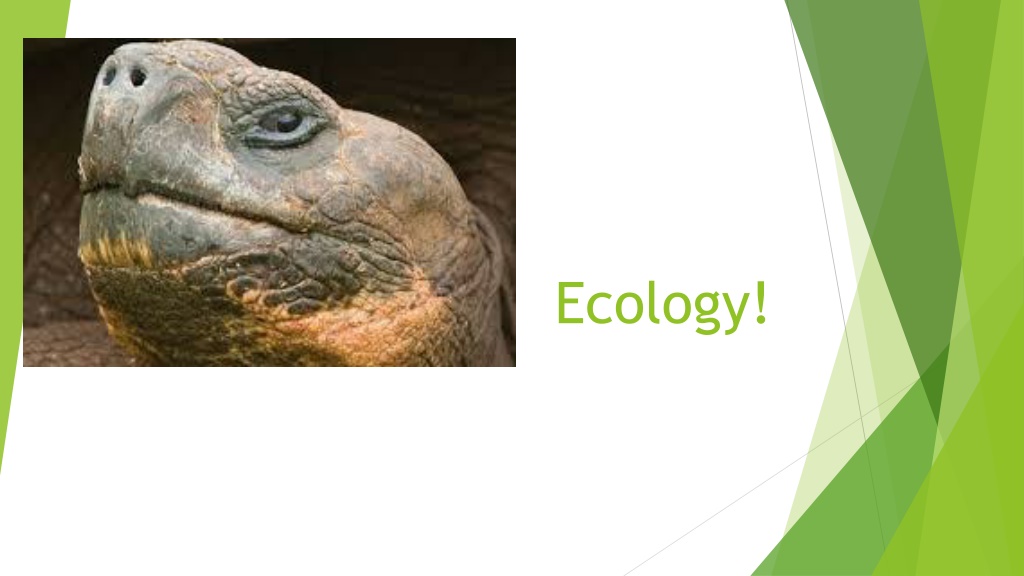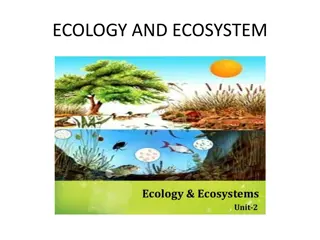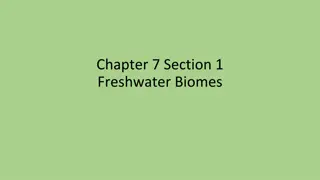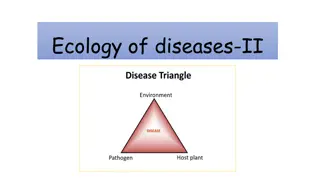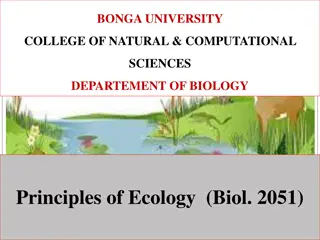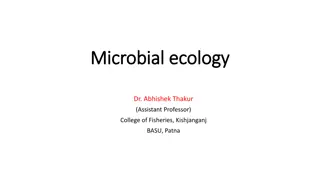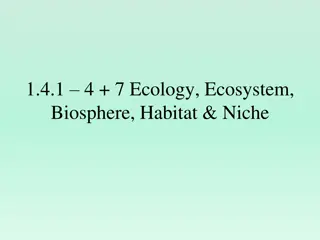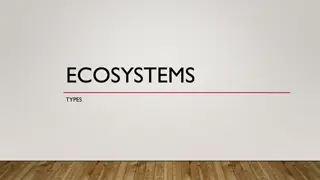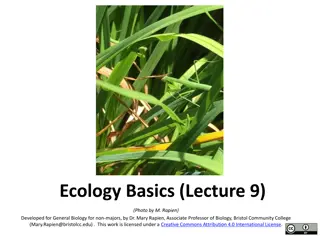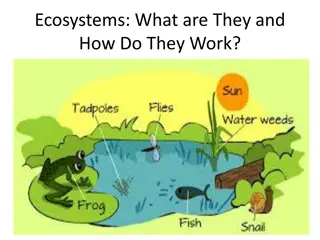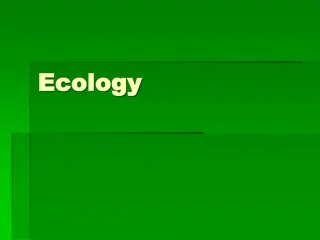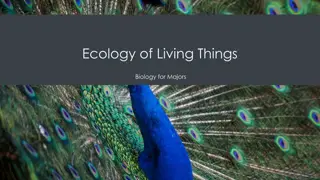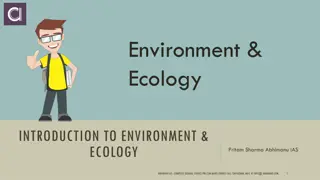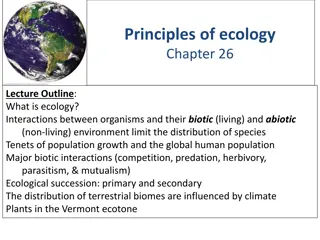Understanding Ecology: Interactions in Ecosystems
Explore the intricate web of interactions in ecosystems through the study of ecology. Learn how biotic and abiotic factors shape ecosystems, trace energy flow, and understand nutrient cycles. Discover the importance of biodiversity and the impact of human activities on the biosphere. Dive into topics like symbiotic relationships, population growth, and ecological footprints.
Download Presentation

Please find below an Image/Link to download the presentation.
The content on the website is provided AS IS for your information and personal use only. It may not be sold, licensed, or shared on other websites without obtaining consent from the author. Download presentation by click this link. If you encounter any issues during the download, it is possible that the publisher has removed the file from their server.
E N D
Presentation Transcript
Learning Targets Describe the study of ecology. Explain how biotic and abiotic factors influence an ecosystem. (outside, Frisbee lab) planaria (effects, Describe how primary producers and consumers obtain energy and nutrients. (Jenn s diary lab, create food chains including specific species ) Trace the flow of energy through living systems. Describe how matter cycles among the living and nonliving parts of an ecosystem. Carbon/water (looking at cycles there using food chains, guided questions, limiting factor here? Why? Using hoola hoop) Mary s young (cheat sheet) Describe how the availability of nutrients affects the productivity of ecosystems. Define a niche. Identify the three types of symbiotic relationships in nature (lecture outside, using hoola hoop). Describe how ecosystems recover from a disturbance. Identify factors that affect population growth. Describe how human activities can affect the biosphere. Define biodiversity and explain its value. Explain the concept of ecological footprint.
Monday (All Classes)___ 9/25/17 Agenda: Warm Up: What does abnormal mean? Happy Monday Complete Radish Lab! Turn in! Begin Ecology Notes Abiotic/Biotic OUTSIDE TOMORROW Learning Targets: Describe the study of ecology. Explain how abiotic and biotic factors influence an ecosystem. What does Abiotic mean?
The Biosphere Chapter 3
Ecology The study of the interactions among organisms and between organisms their environment.
Biosphere All parts of the Earth where life can exist (land, water and air).
Biotic vs. Abiotic Biotic: the living factors in an ecosystem Abiotic: the nonliving factors in an ecosystem
Early Release (3,4)___ 9/27/17 Agenda: Warm Up: How do Abiotic Factors and Biotic Factors influence an ecosystem? Outside: Abiotic and Biotic Factors Create a list of abiotic factors that effect our local ecosystem where we climbed. Learning Targets: Describe the study of ecology. Explain how abiotic and biotic factors influence an ecosystem.
Thursday (All Classes) 9/28/17 Agenda: Producer-Consumer Notes What s for Lunch? Activity Warm Up: How can populations of spiders in Wilderness Park be impacted by birds? Learning Targets: Describe the study of ecology. Explain how abiotic and biotic factors influence an ecosystem.
Levels of Organization Ecosystem: interactions among the community and abiotic factors Community: group of interacting populations Population: group of one species living in the same place at the same time
Energy, Producers, and Consumers
Autotrophs An organism that can make its own food. Use photosynthesis or chemosynthesis. Also called producers.
Heterotrophs An organism that has to get its food from others. Also called consumers.
Types of Heterotrophs Herbivores: eat only plants Carnivores: eat only meat Omnivores: eat both plants and meat Detritovores: break down dead material; decomposers Scavengers: eat dead animals
Energy Flow in Ecosystems
Feeding Relationships Food chains: less complex Food webs: show all eating relationships in an ecosystem. BETTER!
Trophic Levels Each step in a food chain. As you move up trophic levels, 90% of the energy is lost.
Ecological Pyramids Energy Pyramid (kCal)
Friday (All Classes) 9/29/17 Agenda: Complete What s for Lunch? Cycles of Matter Notes Your Personal Ecosystem Warm Up: How can populations of spiders in Wilderness Park be impacted by birds? Learning Targets: Describe the study of ecology. Explain how abiotic and biotic factors influence an ecosystem.
Monday (All Classes) 10/02/17 Agenda: Go over notes! Food Chain Video Water Cycle Lab Warm Up: What is a water shed? Learning Targets: Describe the process of the Water Cycle and its interactions with living things.
Nutrient Chemicals an organism needs to sustain life. Carbon Nitrogen Phosphorous
A-Day (1,2,5,6)_ 10/03/17 Agenda: Go over whats for lunch Notes for Carbon and nitrogen Complete Water Cycle Activity Whale Videos Notes for Niches Warm Up: Please get your note packet and What s for Lunch? Activity out Please get your Water Cycle activity out to be stamped. Through question 4. Warm Up: Please create a mini food web for whales! Learning Target(s) What you should be able to do by the end of today: Trace the flow of energy through living systems. Describe how matter cycles among the living and nonliving parts of an ecosystem.
Ecosystems & Communities Chapter 4
Niches & Community Interactions
Niche Everything an organism does to survive. All physical and biological conditions. What it eats, where it lives (habitat), how it avoids predators, etc.
Competition Occurs when two organisms want the same resource at the same time. Competitive Exclusion Principle: No two species can occupy the same niche at the same time.
Predation An interaction where one organism captures and feeds on another organism. Predator: the killer Prey: the killed
Keystone Species A species that exerts strong control on the structure of a community so that changes to its population causes dramatic changes Ex: sea otters
Symbiosis Any relationship in which two species live closely together. Mutualism: both species benefit Ex: bees and flowers Commensalism: one species benefits while the other is not affected Ex: barnacles on a whale Parasitism: one species benefits, while the other is harmed Ex: tapeworms- YUK! Examples of Symbiosis
Ecological Succession The series of predictable changes that occur in an ecosystem over time. Primary Succession: occurs where there is no soil 1st: lichens; 2nd: mosses; 3rd tree seedlings appear Ex: after a volcano erupts Secondary Succession: occurs where there is soil Ex: after a forest fire
Weather vs. Climate Weather: the day to day condition of the Earth at a particular time and place Climate: the average, year-to-year conditions of temperature and precipitation
Effect of Latitude on Climate The tilt of the Earth creates climate zones based on latitude: Polar Temperate Tropical
Heat Transport in the Biosphere Unequal heating of the Earth drives winds and ocean currents. Air and water near the equator heats and rises.
Ozone Layer Layer of the Earth s atmosphere (13-20 km above Earth) containing ozone (O3). Absorbs 93-99% of UV light.
The Greenhouse Effect Natural situation where gases trap the sun s heat energy in the atmosphere. Maintains our climate. (Earth would be 30 C cooler without it.)
Humans in the Biosphere
Carrying Capacity The maximum number of individuals of a particular species that a particular environment can support.
Resources Renewable Resource: can be replaced by a healthy ecosystem Ex: trees, wind Nonrenewable Resource: can t be replenished by natural processes in a reasonable amount of time Ex: fossil fuels
Biological Magnification Increasing concentration of a harmful substance in organisms at higher trophic levels in a food chain
Biodiversity All of the organisms in the biosphere Ecological hot spot: a place where significant numbers of species and habitats are in immediate danger of extinction
Conservation wise use studying the loss of biodiversity & ways it can be prevented
Ecological footprint The total area of functioning land and water ecosystems needed to provide resources and absorb the wastes of an individual or population. Used to calculate the biosphere s carrying capacity for humans.
